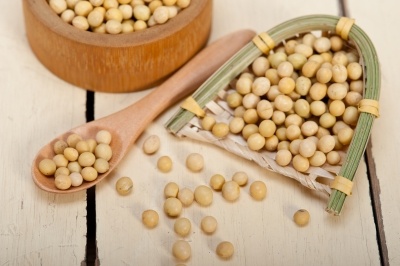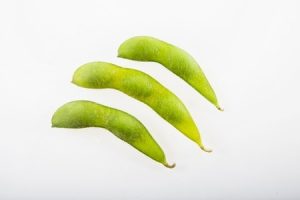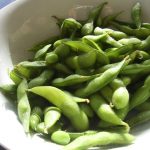
Soya or just soy (Glycine max. L.) has developed into one of the most important nutritional foods throughout the world with strong health benefits. It has been known for much longer by people in the Far East who were eating it for many centuries. Not surprisingly it attracted the attention of Western nations in the 70’s, who began to use soy sauce in Chinese cuisine, to replace meat with a vegetarian equivalent based on soy, or simply eat it as a health food.

The Growth Of Soya as a Food, Ingredient And Health Product
Commercially, the sales of soya in both food and beverage was reported to be $1.4 billion which is a 15% increase since reported figures in 2003. One particular product type, the soya milks has grown over 60% in 5 years to 2008 with continuing growth. The other major soy segment are the snack bars which have developed with increasing prominence as meal replacement foods (Heyl-Rushmer, 2009).
The FDA (1999) then stated that 25g of soybean protein per day was useful for preventing cardiovascular disease (CVDs) based on the evidence for a reduction of low-density lipoprotein cholesterol (LDLs) in hypercholesterolemic subjects. Once the FDA in the States had approved this critical health claim, it started to become a serious food, especially for vegetarians and milk-intolerant consumers. However, the claim is being reassessed in the light of controversial evidence which disputes these findings.
Those affected by coeliac disease prefer the isolates and concentrates by making excellent functional ingredients.
There is a plethora of nutritional evidence associated now with soya, the beans and its derivative products, soy protein isolates and concentrates, soybean oil, soy milk, defatted flour, as textured protein and tofu. Soy lecithin is a highly valued emulsifier for oil and lipid preparations so it also brings useful functional benefits. Soya beans are legumes that are high in fibre, minerals such as potassium and vitamins such as folate. Soya protein contains all the essential amino acids, making it complete. Soybeans also contain some key lipids such as various omega-3 fatty acids and in particular alpha-linolenic acid (ALA). It’s worth noting that the highest content of this important fatty acid is found in flaxseed oil.
Compounds In Soya
The most important componentry appears to be:-
♦ Saponins
♦ Isoflavones (acting as antioxidants) such as genistein and diadzein.
♦ Phytosterols
As a protein, it has no real benefit over whey or casein except for its amino-acid profile which might be more attractive to those seeking a more balanced intake. Most athletes for example prefer this protein because of its high glutamine, branched chain amino acid profile (BCAA) and arginine content. There is still considerable research to be conducted on finding ways and means to reduce the undesirable off-notes which develop if soy is not processed properly. There is also a situation where flavour compounds will bind to the soy protein leading to a reduction in taste impact (Suppavorasatit and Cadwallader, 2010).
The heart related benefit has been linked to its proteins (Lovati et al., 2000; Fukui et al., 2002; Anderson, 2003) especially the alpha subunit of the 7S globulins (Manzoni et al., 2003). At current levels, the average Asian diet contains between 20 to 50 mg isoflavones (Adlercreutz et al., 1991; Nagata et al., 1997) whereas in Western regions the level is about 100 fold lower ranging from 0.15 µg/day to 3 mg/day in the USA. This intake level is starting to rise however. The isoflavones of interest are derived from the glycosides, genistin and daidzin which are converted to genistein and daidzein in the body (Barnes et al., 1994; Adlercreutz, 1995).

One of the more intriguing aspects of a soya-rich diet is the potential for a reduction in prostate cancer. Cautiously over many years, epidemiological evidence has been gathered to show an inverse association between soy consumption and prostate cancer risk (Rose et al., 1986; Mills et al., 1989; Shimizu et al., 1991; Giovanucci, 1995). The link is made to the ingestion of soy isoflavones, particularly genistein and a number of mechanisms have been suggested as to how this link might be enacted.
Genistein is now being linked to a reduction in breast cancer formation due to an important interaction with a gene involved in suppressing tumours.
Types
There are a couple of varieties worth noting. The yellow skinned type is more commonly available in stores but the black coated soybean has attracted attention.
Nutritionally, the black soy beans are virtually the same as the yellow type, though they are higher in some phytonutrients, including various antioxidants. The anthocyanin content is slightly higher in the black variety hence the stronger claims.
As the 21st Century progresses, the interest in soy as an ingredient continues to excite interest.
Revision
Revised 1st November 2017 to reflect the FDA uncertainly about the cardiovascular protective effect of soy. Further information to be provided once the situation is more clearly understood.
References
Adlercreutz, H. (1995) Phytoestrogens: Epidemiology and a possible role in cancer protection. Environ. Health Perspect. 103 Suppl. 7: pp. 103 – 12.
Adlercreutz, H., Honjo, H., Higashi, A., Fotsis, T., Hämäläinen, E., Hasegawa, T., Okada, H. (1991) Urinary excretion of lignans and isoflavonoid phytoestrogens in Japanese men and women consuming traditional Japanese diet. Am. J. Clin. Nutr. 54 pp. 1093–1100
Anderson, J. W. (2003) Diet first, then medication for hypercholesterolemia. JAMA 290 pp. 531–533
_________., Johnstone, B.M., Cook-Newell, M.E. (1995) Meta-analysis of the effects of soy protein on serum lipids. N Engl. J of Med. 333 pp. 276–282
Barnes, S., Peterson, G., Grubbs, C., Setchell, K. (1994) Potential role of dietary isoflavones in the prevention of cancer. In: Jacobs, M.M., editor. Diet and cancer: markers, prevention, and treatment. New York: Plenum Press. pp. 135 – 47
Chen, Z., Zheng, W., Custer, L.J., Dai, Q., Shu, X.O., Jin, F., Franke, A.A. (1999) Usual dietary consumption of soy foods and its correlation with the excretion rate
De Kleijn, M.J.J., van der Schouw, Y.T., Wilson, P.W.F., Adlercreutz, H., Mazur, W., Grobbee, D.E., Jacques, P.F. (2001) Intake of dietary phytoestrogens is low in postmenopausal women in the United States: The Framingham study. J. Nutr. 131 pp. 1826–1832
FDA Talk Paper (1999) New health claim proposed for relationship of soy protein and coronary heart disease. Federal register 64 pp. 57699–57733
Fukui, J.K., Tachibana, N., Wanezaki, S., Tsuzaki, S., Takamatsu, K., Yamamoto, T., Hashimoto, Y., Shimoda, T. (2002) J. Agric. Food Chem. 50 pp. 5717–5721
Giovanucci, E. (1995) Epidemiological characteristics of prostate cancer. Cancer 75, pp. 1766–1777
Heyl-Rushmer, M. (2009) Soy-based food and drink. Prepared Foods. 178(4) pp. 13-19
Horn-Ross, P.L., John, E.M., Lee, M., Stewart, S.L., Koo, J., Sakoda, L.C., Shiau, A.C., Goldstein, J., Davis, P., Perez-Stable, E.J. (2001) Phytoestrogen consumption and breast cancer risk in a multiethnic population: the Bay Area Breast Cancer Study. Am. J. Epidemiol. 154 pp.434–441
Lovati, M.R., Manzoni, C., Gianazza, E., Arnoldi, A., Kurowska, E., Carroll, K.K., Sirtori, C.R. (2000) Soy protein peptides regulate cholesterol homeostasis in Hep G2 cells. J. Nutr. 130 pp 2543–2549
Manzoni, C., Duranti, M., Eberini, I., Scharnag, H., Marz, W., Castiglioni, S., Lovati, M.R. (2003) Subcellular localization of soybean 7S globulin in HepG2 cells and LDL receptor up-regulation by its alpha’ constituent subunit. J Nutr. 133 pp 2149–2155
Mills, P.K., Beeson, W.L., Phillips, R.L., Fraser, G.E. (1989) Cohort study of diet, lifestyle, and prostate cancer in Adventist men. Cancer 64, pp. 598–604
Nagata, C., Kabuto, M., Kurisu, Y., Shimizu, H. (1997) Decreased serum estradiol concentration associated with high dietary intake of soy products in premenopausal Japanese women. Nutr. Cancer 29 pp. 228
Rose, D.P., Boyar, A.P., Wynder, E.L. (1986) International comparison of mortality rates for cancer of the breast, ovary, prostate and colon, and per capita food consumption. Cancer 58, pp. 2363–2371
Shimizu, H., Ross, R.K., Bernstein, L., Yatani, R., Henderson, B.E., et al.: (1991) Cancers of the prostate and breast among Japanese and white immigrants in Los Angeles County. Br J Cancer 63, pp. 963–966
Sirtori, C.R., Agradi, E., Conti, F., Mantero, O., Gatti, E. (1977) Soybean-protein diet in the treatment of type-II hyperlipoproteinaemia. Lancet pp. 275–277
Sirtori, C.R., Lovati, M.R., Manzoni, C., Gianazza, E., Bondioli, A., Staels, B., Auwerx, J. (1998) Reduction of serum cholesterol by soy proteins. Nutrition, Metabolism and Cardiovascular Disease 8 pp.334–340
Suppavorasatit, I., Cadwallader, K.R. (2010) Flavor-soy protein interactions. In: Chemistry, texture, And Flavor Of Soy. Cadwallader, K.R., Chang, S.K.R., Edts. Washington D.C.,: American Chemical Society. pp. 339-359


Leave a Reply